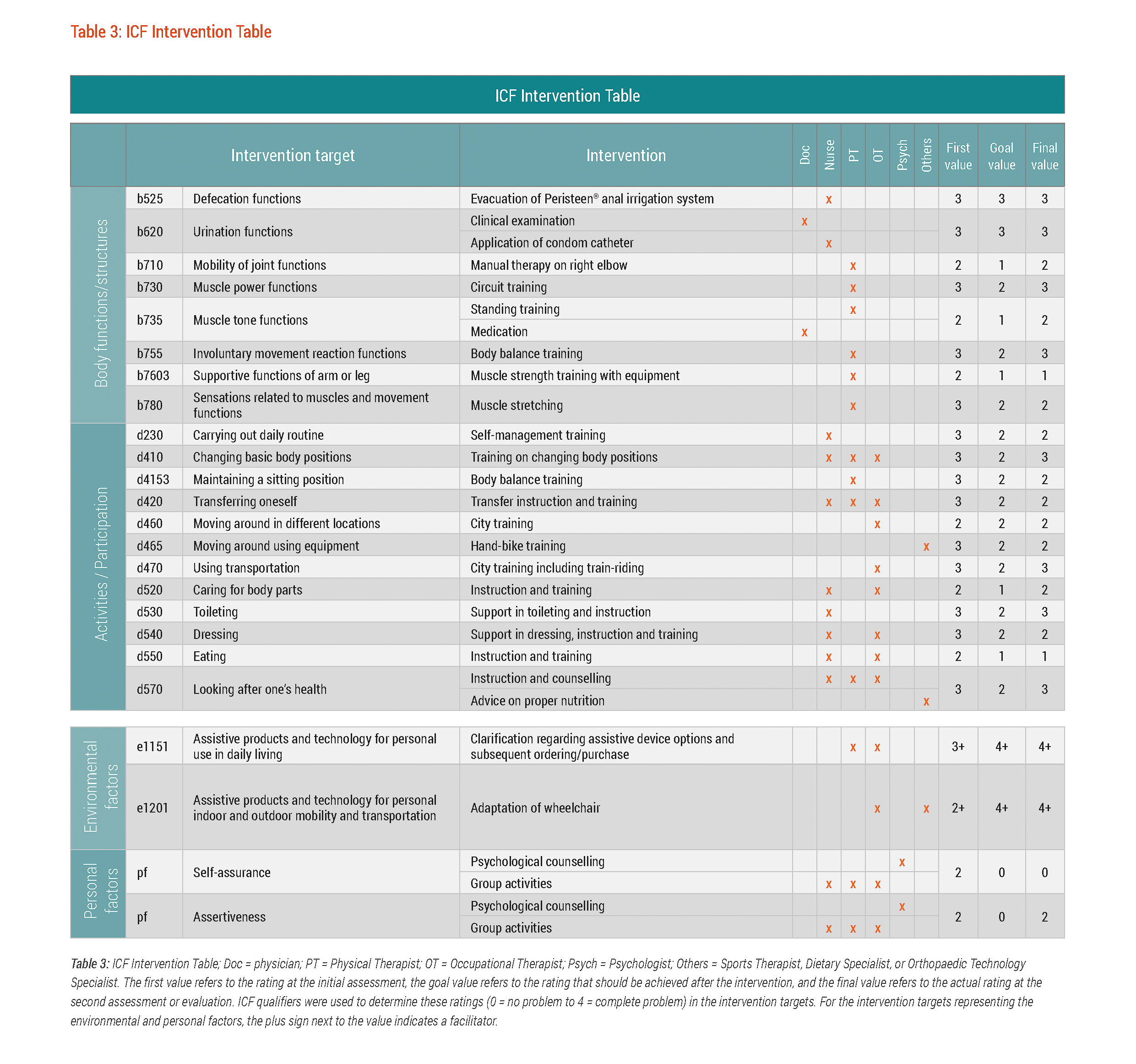Assignment and Intervention

Interventions Targeting Mobility
Specific interventions to improve mobility were performed by both the OT and the PT. While the PT focused on addressing intervention targets from the body functions perspective, the OT provided interventions that targeted activities and participation. For example, the PT performed manual therapy to improve joint mobility (b710), guided Stefan in completing regular circuit training to increase muscle power (b730), especially in his arms, and muscle strength training to improve supportive functions of his arms (b7603). The PT also provided body balance training to help Stefan enhance his ability to maintain a sitting position (d4153). These intervention targets, in turn, were essential for improving Stefan's transferring skills. Transferring to and from the wheelchair (d420) – a crucial skill for being independent in daily living – was addressed by the OT, as well as by the PT and nurse, through instruction and regular transfer training.
""...the interventions provided also aimed at optimising the amount of time Stefan needed for indoor and outdoor mobility.""
The OT also provided city training, in both individual and group sessions, to help Stefan improve his outdoor mobility, specifically his abilities to manoeuvre the wheelchair in different locations (d460) such as streets, railway stations, trains, elevators. The group activities included Stefan's participation in a wheelchair club, weekly group counselling sessions during brunch, and visits to the circus, a zoo and a local lakeside café. Additionally, Stefan contributed to a group project that helped train his ability to plan tasks and actions, effective communication, and cooperation with others toward achieving a common goal.
Using public transportation (d470), specifically the train, was difficult for Stefan. Getting into an elevator at the train station with the Swiss-TracTM was almost impossible since it took too much time to completely manoeuvre his wheelchair and Swiss-TracTM into the elevator before the doors closed. Once inside the train Stefan took a lot of time to undock the Swiss-TracTM and take a place in the wheelchair compartment. Moreover, he was afraid of moving around in his wheelchair in the train. These are among the mobility problems that slowed Stefan down in everyday life. Thus, the interventions provided also aimed at optimising the amount of time Stefan needed for indoor and outdoor mobility.
In addition to the PT, OT, and the nurse, the physician also provided interventions to address Stefan's mobility issues i.e. the physician prescribed medication to reduce the spasticity Stefan had been experiencing.
Interventions Targeting Self-Care
The physician together with the nurse also contributed to addressing the problems Stefan had with toileting (d530), specifically the body functions aspects of toileting. The physician conducted regular clinical examinations, while the nurse assisted Stefan with using a device to clear his bowel and in applying the condom catheter, and provided related instruction. The nurse was also instrumental in addressing other intervention targets in self-care together with the OT.
Shaving with the electric shaver is difficult for Stefan, since he doesn’t know how much pressure is needed. It takes him about ten minutes to finish shaving – much longer than another person would require.
Stefan’s OT at the time of assessment
To improve Stefan’s independence in self-care, the nurse and OT provided instruction and self-management training in caring for body parts (d520), dressing (d540), eating (d550), and looking after his health (d570). The OT assisted Stefan in finding compensation strategies to independently perform self-care activities and in a time-efficient manner.
Interventions Targeting Contextual Factors
Members of the rehabilitation team coordinated their interventions to address contextual (environmental and personal) factors that impacted Stefan's independence in mobility and self-care. For example, both the PT and OT were involved in clarifying the ideal assistive devices for use in daily living (e1151).
Stefan had difficulties docking the Swiss-TracTM to his wheelchair. Subsequently, a special funnel was attached that facilitated his handling of the wheelchair.
Stefan’s OT
With regard to Stefan's personal factors, a psychologist provided counselling to help improve Stefan’s assertiveness and self-confidence. This was supported by the group activities led by the nurse, PT and/or OT.
An Overview of Assignment and Intervention
Each of the intervention targets was assigned to one or more of the rehabilitation team members. The ICF Intervention Table provided an at-a-glance overview of the assignment of the intervention target to the respective team member(s) as well as the ICF qualifier values defined for the first value and goal value as documented on the ICF Categorical Profile.{BITTE BEIM "ICF CATEGORICAL PROFILE" EINEN ANKER zum 3. Absatz unter Goal-setting/Determination of Intervention Targets, der mit "These three goals..." anfängt, SETZEN. DANKE DIR.} See table 3.

Table 3: ICF Intervention Table; Doc = physician; PT = Physical Therapist; OT = Occupational Therapist; Psych = Psychologist; Others = Sports Therapist, Dietary Specialist, or Orthopaedic Technology Specialist. The first value refers to the rating at the initial assessment, the goal value refers to the rating that should be achieved after the intervention, and the final value refers to the actual rating at the second assessment or evaluation. ICF qualifiers were used to determine these ratings (0 = no problem to 4 = complete problem) in the intervention targets. For the intervention targets representing the environmental and personal factors, the plus sign next to the value indicates a facilitator.